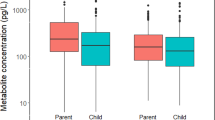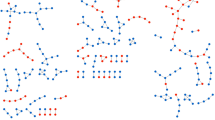Abstract
The Agency for Toxic Substances and Disease Registry (ATSDR) conducted biological testing to assess dioxin exposure in residents of a community who lived in an area with heavy chemical industry. Dioxin concentrations were measured in blood serum samples from 28 adult residents of the community. Fourteen of those tested had blood dioxin concentrations that exceeded the 95th percentile prediction level of an age-matched comparison population. Specific congener analyses indicated that the elevated dioxin concentrations were primarily due to high concentrations of 2,3,7,8 tetrachlorodibenzo-p-dioxin (TCDD), 1,2,3,7,8 pentachlorodibenzo-p-dioxin (PeCDD), and hexachlorodibenzo-p-dioxins (HxCDs). Principal components analysis (PCA) indicated that the profiles of dioxin congeners were different in people with elevated blood dioxin concentrations compared to those with background concentrations. Elevated blood dioxin concentrations were detected only in older members of the population, which suggests that dioxin exposures were higher in the past. The sources of the dioxin exposure have not been identified.
This is a preview of subscription content, access via your institution
Access options
Subscribe to this journal
Receive 6 print issues and online access
$259.00 per year
only $43.17 per issue
Buy this article
- Purchase on Springer Link
- Instant access to full article PDF
Prices may be subject to local taxes which are calculated during checkout


Similar content being viewed by others
References
Akins, J. R., Waldrep, K. and Bernert, J. T. Jr. The estimation of total serum lipids by a completely enzymatic “summation” method. Clin Chim Acta. (1989) 184: 219–226.
Alcock, R. E. and Jones, K. C. Dioxins in the environment: a review of trend data. Environ Sci Technol. (1996) 30: 3133–3143.
Calcasieu Parish Office of Emergency Preparedness. Emergency Release Notification Records. (1999.
Cruczwa, J., and Hites, R. Airborne dioxins and dibenzofurans: sources and fates. Environ Sci Technol. (1986) 20(2): 195–200.
DeVito, M. J., Birnbaum, L. S., Farland, W. H. and Gasiewicz, Tal Comparisons of estimated human body burdens of dioxinlike chemicals and TCDD body burdens in experimentally exposed animals. Environ Health Perspect. (1995) 103: 820–831.
U.S. Environmental Protection Agency. Estimating exposure to dioxin-like compounds: Volume II. Properties, sources, occurrence and background exposures. Washington, DC, EPA/600/6-88/005Cb. (June 1994a) 3: 1–194.
U.S. Environmental Protection Agency. Cited in U.S. Environmental Protection Agency. Estimating exposure to dioxin-like compounds: Volume II. Properties, sources, occurrence and background exposures. Washington, DC, EPA/600/6-88/005Cb. (June 1994b) 5: 18–19.
U.S. Environmental Protection Agency. Estimating exposure to dioxin-like compounds: Volume II. Properties, sources, occurrence and background exposures. Washington, DC, EPA/600/6-88/005Cb. (June 1994c) 5: 1–12.
U.S. Environmental Protection Agency. Exposure and human health reassessment of 2,3,7,8-tetrachlorodibenzo-p-dioxin (TCDD) and related compounds: Part III. Integrated summary and risk characterization for 2,3,7,8-tetrachlorodibenzo-p-dioxin (TCDD) and related compounds. Washington, DC, EPA/600/P-00/001Ag. (June 2000) 57–59.
Flesch-Janys, D., Becher, H., Gurn, P., Jung, D., Konietzko, J., Manz, A., and Papke, O. Elimination of polychlorinated dibenzo-p-dioxins and dibenzofurans in occupationally exposed persons. J Toxicol Environ Health. (1996) 47: 363–378.
Furst, P., Furst, C., and Wilmers, K. Human milk as a bioindicator for body burden of PCDDs, PCDFs, organochlorine pesticides, and PCBs. Environ Health Perspect Suppl. (1994) 102(suppl 1): 187–193.
Hazardous Substances Data Bank [database online]. Bethesda, MD: National Library of Medicine. 2001.
Needham, L. L., Patterson, D. G., Burse, V. W., Pascal, D. C., Turner, W. E. and Hill, R. H. Jr. Reference range data for assessing exposure to selected environmental toxicants. Toxicol Ind Health. (1996) 12: 507–513.
Neter, J., Wasserman, W., and Kutner, M. Applied Linear Statistical Models: Regression, Analysis of Variance, and Experimental Designs. 3rd ed. Irwin, Boston. 1990.
Papke, O. Cited in International Agency for Research on Cancer. IARC Monographs on the Evaluation of Carcinogenic Risks to Humans: Polychlorinated Dibenzo-para-dioxins and Polychlorinated Dibenzofurans. (1997) 69: 114
Patterson, D. G., Isaacs, S. G., Alexander, L. R., Turner, W. E., Hampton, L., Bernert, J. T. and Needham, L. L. Method 6: Determination of specific polychlorinated dibenzo-p-dioxins and dibenzofurans in blood and adipose tissue by isotope dilution–high-resolution mass spectroscopy In: Rappe C., Buser H.R. (Eds.), Environmental Carcinogens-Methods of Analysis and Exposure Measurement Vol. 11 WHO, International Association for Research on Cancer, Lyon, France. 1991, pp. 291–342.
Rencher, A. C. Methods of Multivariate Analysis. Wiley, New York. 1995.
Turner, W., DiPietro, E., Lapenza, C., Green, V., Gill, J., and Patterson, D. J. A fast universal automated cleanup system for the isotope-dilution high-resolution mass spectrometric analysis of PCDDs, PCDFs, coplanar PCBs, and persistent pesticides from the same serum sample. Organohalogen Compd. (1997) 31: 26–31.
Van den Berg, M., Birnbaum, L., Bosveld, A., Brunstrom, B., and Cook, P. Toxic equivalency factors (TEFs) for PCBs, PCDDs, PCDFs for humans and wildlife. Environ Health Perspect. (1998) 106(12): 775–792.
Acknowledgements
The authors thank Dr. Richard A. Canady for developing the dioxin comparison values cited in this report. The authors also thank the residents of the community for their generous assistance and participation in this investigation.
Author information
Authors and Affiliations
Corresponding author
Rights and permissions
About this article
Cite this article
ORLOFF, K., HEWITT, D., METCALF, S. et al. Dioxin exposure in a residential community. J Expo Sci Environ Epidemiol 11, 352–358 (2001). https://doi.org/10.1038/sj.jea.7500175
Received:
Published:
Issue Date:
DOI: https://doi.org/10.1038/sj.jea.7500175
Keywords
This article is cited by
-
Serum dioxin levels in residents of Calcasieu and Lafayette parishes, Louisiana with comparison to the US population
Journal of Exposure Science & Environmental Epidemiology (2008)
-
Serum concentrations of chlorinated dibenzo-p-dioxins and dibenzofurans among former Michigan trichlorophenol and pentachlorophenol workers
Journal of Exposure Science & Environmental Epidemiology (2007)
-
Predictors of serum dioxin levels among adolescent boys in Chapaevsk, Russia: A cross-sectional pilot study
Environmental Health (2005)
-
Levels of dioxins and furans in plasma of nonoccupationally exposed subjects living near a hazardous waste incinerator
Journal of Exposure Science & Environmental Epidemiology (2005)
-
Communicating results to community residents: Lessons from recent ATSDR health investigations
Journal of Exposure Science & Environmental Epidemiology (2004)



